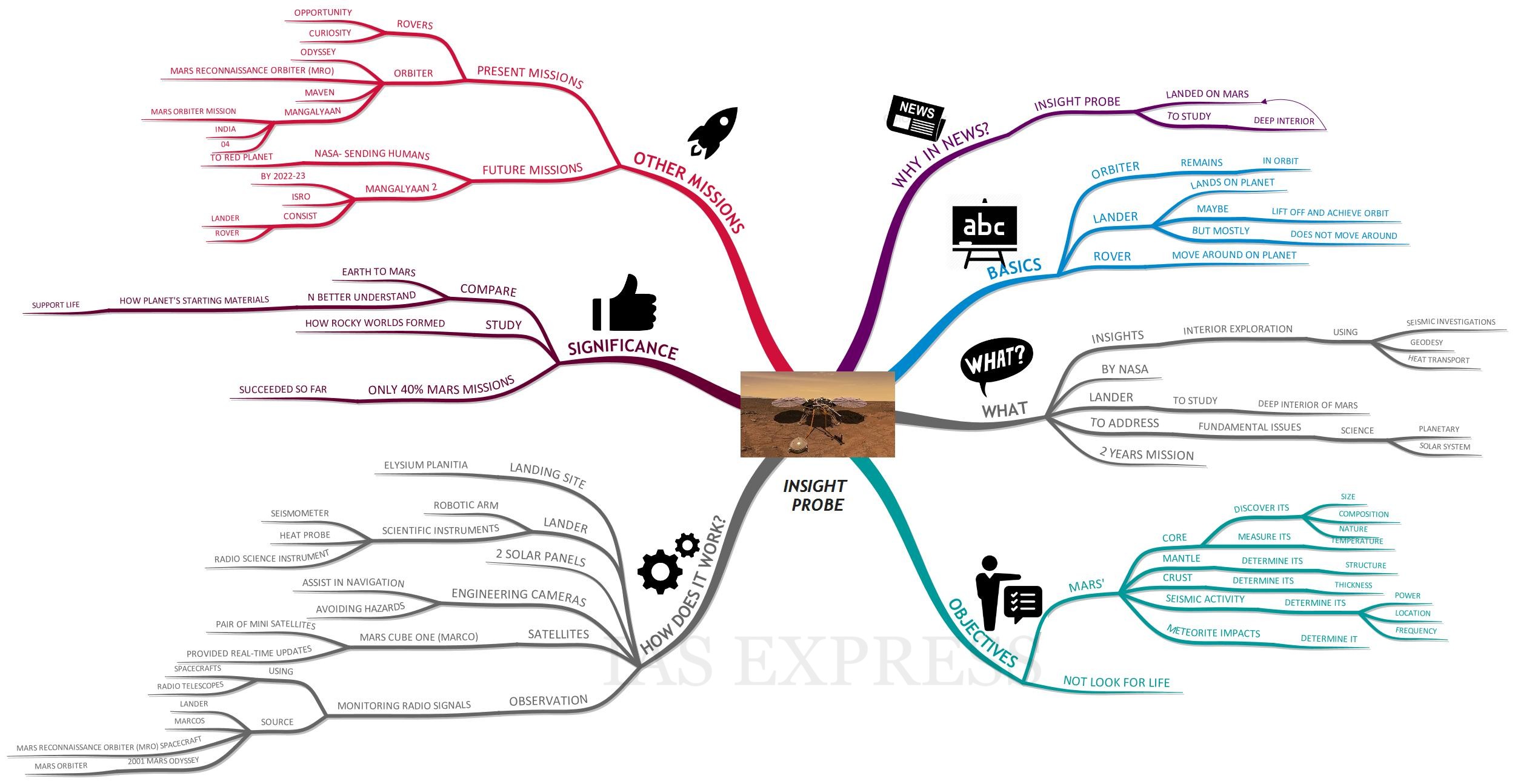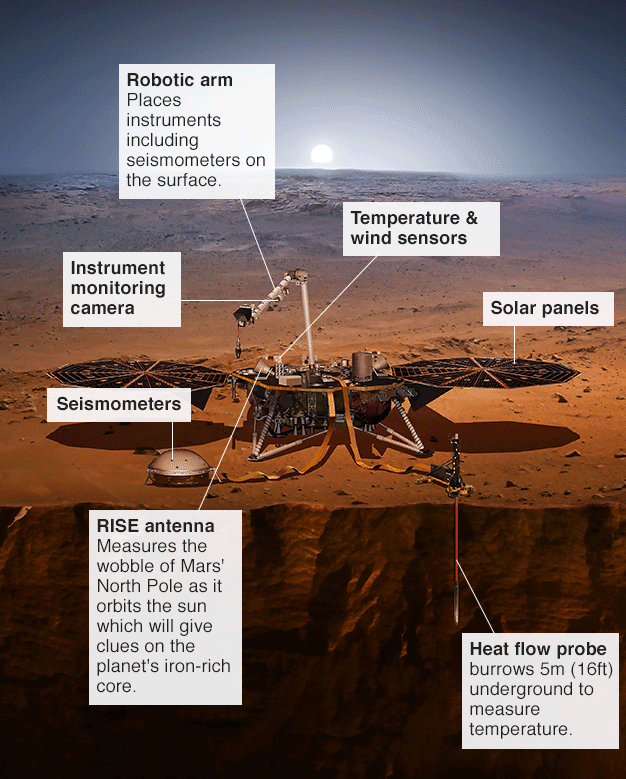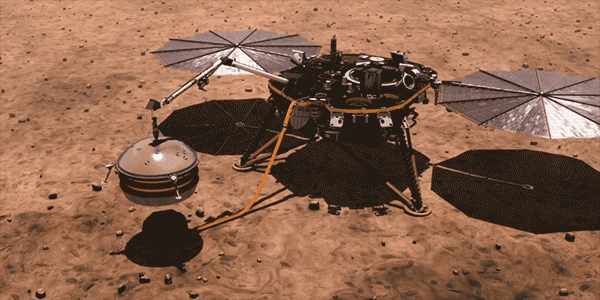NASA’s InSight Mission – Exploring the uncharted territory of Mars

Recently, NASA’s InSight probe was successfully landed on the Red Planet to study its deep interior and make it the only planet apart from Earth to be examined this way. InSight is the first outer space robotic explorer to study the interior of Mars – its crust, mantle, and core.

Basics
Orbiter: An orbiter performs its mission while remaining in orbit of the planet.
Lander: A lander touches down on the planet and may be able to take off and achieve orbit again but otherwise does not move around.
Rover: A rover is capable of moving around through its own power after it has landed on a planet.
What is InSight mission?
- Interior Exploration using Seismic Investigations, Geodesy, and Heat Transport (InSight).
- It is a lander designed by NASA to study the deep interior of Mars by taking the planet’s vital signs, its pulse and temperature.
- It aims to address one of the most fundamental issues of planetary and solar system science.
- It is a two years mission.
- It was NASA’s 9th attempt to land on Mars since the 1976 Viking probes. NASA last landed on Mars in 2012 with the Curiosity rover.
What are the objectives of the InSight mission?
- Discover the size, composition, and nature of the core of the red planet.
- Measure the temperature of the core.
- Determine the structure of the mantle.
- Determine the thickness of the crust.
- Determine the power, location, and frequency of seismic activity on Mars.
- Figure out how often meteorites impact the planet.
- It will not look for life on Mars.
How does it work?
Landing Site
- The landing site is Elysium Planitia, where InSight can stay still and quiet all through.
- Elysium Planitia is a vast, smooth lava plain that NASA calls the biggest parking lot on Mars.
- This featureless and quiet landscape is well-suited for the mission to map the interior of the Mars.
Lander
- The Lander carries a robotic arm of 1.8 m long.
- The lander uses scientific instruments to study the properties and dimensions of the planet’s core, mantle, and crust.
- Seismometer or SEIS – to measure seismic activity.
- Heat Probe or HP3 – Measures the temperature of the core.
- Radio Science Instrument or RISE – Measures the wobble (unsteadiness) of the north pole.
- It is powered by two solar panels.
- Two complementary engineering cameras assist in navigation and avoiding hazards.
Satellites
- In addition to the lander, a pair of mini satellites named Mars Cube One or MarCO also reached Mars.
- They provided real-time updates of the spacecraft’s supersonic descent.
Observation
- NASA team from Earth will be monitoring radio signals utilising different spacecraft as well as radio telescopes on Earth.
- Signals will from come from different sources viz – The lander, MarCOs, the Mars Reconnaissance Orbiter (MRO) spacecraft during descent and the 2001 Mars Odyssey (Mars Orbiter).
What is the significance of the mission?
- Earth and Mars used to be similar i.e., warm, wet and full of thick atmospheres. However, this was before when they took different paths 3.4 billion years ago. After the event, Mars stopped changing, however, Earth continued to evolve. They turned out to be so different viz., Mars (Cold and Dry), Venus and Mercury (Burning Hot), and Earth (Hospitable to life).
- With InSight lander, scientists could be able to compare Earth to Mars and better understand how a planet’s starting materials make it more or less likely to support life.
- It is hence expected to study how Mars and other rocky worlds formed at the dawn of the solar system over 4.6 billion years ago.
- It has to be noted that, sending a probe to Mars, whether to land, orbit or fly past, is risky = only 40 percent of missions have succeeded so far.
Also read: GSLV Mark III launches GSAT 29 – A Major boost to Moon and Manned Space Missions
What is the legacy here?
- Mars has been the graveyard for many space missions.
- Until now, the success rate at the red planet has been only 40% since 1960.
- The US, however, has pulled off 7 successful Mars landings in the past 4 decades, not counting InSight, with only one failed touchdown.
- No other country has managed to land and operate a spacecraft on the dusty red surface.
Also read: Gaganyaan Mission – India’s quest towards putting Indians in Space
What are the other missions to Mars?
Present missions
- Opportunity and Curiosity rovers have been exploring the Martian surface.
- Odyssey and Mars Reconnaissance Orbiter (MRO) spacecraft currently orbiting the planet.
- MAVEN (Mars Atmosphere and Volatile Evolution Mission) orbiter has been helping scientists understand what happened to the Martian atmosphere.
- In 2014, India successfully launched its first orbital mission named Mangalyaan (Mars Orbiter Mission-MOM) into Mars’ orbit.
Future missions
- NASA is currently working on sending humans to the Red Planet.
- ISRO is planning to launch a follow-up mission named Mangalyaan 2 by 2022-23. This mission will likely consist of a Lander and Mars Rover.
Related UPSC Mains 2017 GS1 question: How does the Juno Mission of NASA help to understand the origin and evolution of the Earth? (150 words, 10 Marks)
If you like this post, please share your feedback in the comments section below so that we will upload more posts like this.



